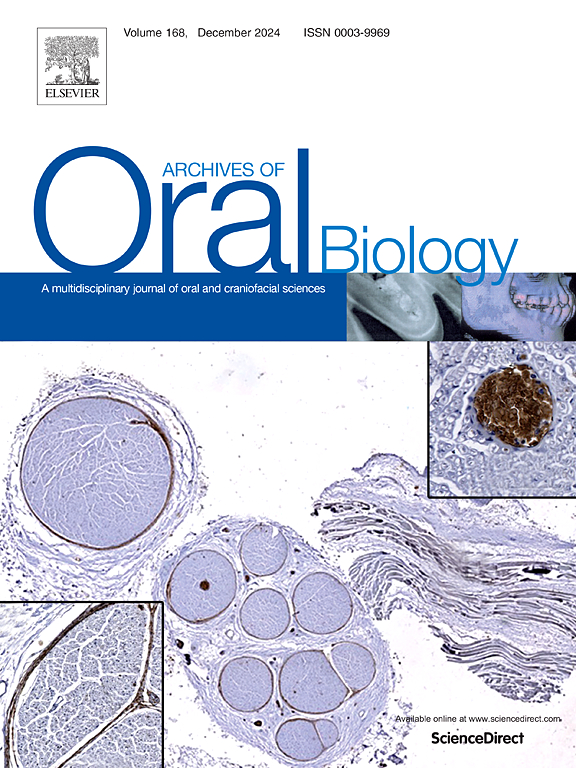牙周病的选择性细菌蛋白水解:分子机制和治疗意义
IF 2.1
4区 医学
Q2 DENTISTRY, ORAL SURGERY & MEDICINE
引用次数: 0
摘要
背景/目的牙周病的特点是免疫系统、口腔细菌、宿主组织和各种外部和内部因素之间复杂的相互作用。疾病进展的一个标志是细菌蛋白酶对宿主蛋白的选择性降解。这篇综述探讨了细菌蛋白水解的分子机制,重点是对口腔内稳态所必需的宿主蛋白的选择性。方法利用PubMed、Scopus、Web of Science等数据库进行近20年的文献检索。搜索词包括“降解”、“口腔组织”、“蛋白质”、“细菌”、“牙周病”、“牙周炎”、“途径”和“宿主”。使用布尔运算符和过滤器来优化结果。文章根据标题、摘要和全文进行评估。通过引文跟踪确定了其他参考文献。采用叙事综合方法整合研究结果。结果细菌蛋白酶具有精确的底物识别能力,针对口腔环境中的特定结构、免疫和信号蛋白。蛋白质水解特征和疾病病理是由微生物群落动态形成的,包括合作和竞争的相互作用。宿主因素如遗传多样性、局部微环境条件和免疫反应进一步调节蛋白质降解。尽管取得了进展,但关键的差距仍然存在,特别是在翻译后修饰和蛋白水解特异性的决定因素方面。结论细菌选择性蛋白水解在牙周病发病中起关键作用。通过先进的蛋白质组学、纵向研究和成像技术来解决目前的知识差距,对于制定有针对性的诊断和治疗策略至关重要。需要一种综合的方法来加强牙周病的管理和改善患者的预后。本文章由计算机程序翻译,如有差异,请以英文原文为准。
Selective bacterial proteolysis in periodontal disease: Molecular mechanisms and therapeutic implications, a narrative review
Background/Objective
Periodontal diseases are characterized by complex interactions between the immune system, oral bacteria, host tissues, and various external and internal factors. A hallmark of disease progression is the selective degradation of host proteins by bacterial proteases. This review explores the molecular mechanisms of bacterial proteolysis, with a focus on the selectivity toward host proteins essential for oral homeostasis.
Methods
An extensive electronic search was conducted using PubMed, Scopus, and Web of Science, covering the last 20 years. Search terms included “degradation,” “oral tissue,” “proteins,” “bacteria,” “periodontal disease,” “periodontitis,” “pathways,” and “host.” Boolean operators and filters were applied to refine results. Articles were evaluated based on titles, abstracts, and full texts. Additional references were identified through citation tracking. A narrative synthesis approach was used to integrate findings.
Results
Bacterial proteases exhibit precise substrate recognition, targeting specific structural, immune, and signaling proteins in the oral environment. The proteolytic profile and disease pathology are shaped by microbial community dynamics, including cooperative and competitive interactions. Host factors such as genetic diversity, local microenvironmental conditions, and immune responses further modulate protein degradation. Despite advancements, critical gaps remain, particularly regarding post-translational modifications and the determinants of proteolytic specificity.
Conclusions
Selective bacterial proteolysis plays a pivotal role in periodontal disease pathogenesis. Addressing current knowledge gaps through advanced proteomics, longitudinal studies, and imaging technologies is essential for developing targeted diagnostic and therapeutic strategies. An integrative approach is needed to enhance periodontal disease management and improve patient outcomes.
求助全文
通过发布文献求助,成功后即可免费获取论文全文。
去求助
来源期刊

Archives of oral biology
医学-牙科与口腔外科
CiteScore
5.10
自引率
3.30%
发文量
177
审稿时长
26 days
期刊介绍:
Archives of Oral Biology is an international journal which aims to publish papers of the highest scientific quality in the oral and craniofacial sciences. The journal is particularly interested in research which advances knowledge in the mechanisms of craniofacial development and disease, including:
Cell and molecular biology
Molecular genetics
Immunology
Pathogenesis
Cellular microbiology
Embryology
Syndromology
Forensic dentistry
 求助内容:
求助内容: 应助结果提醒方式:
应助结果提醒方式:


